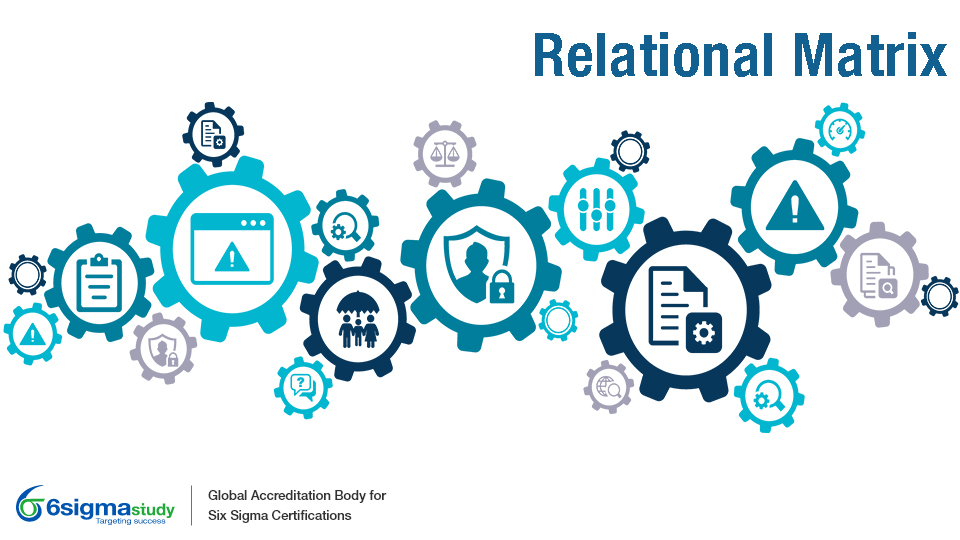Relational Matrix/Prioritization Matrix
Posted by 6sigmastudy® on September 12, 2023 | Six Sigma Methodology
Keywords: Six Sigma 6sigmastudy Six Sigma Yellow Belt (SSYB™) Six Sigma Green Belt (SSGB™) Six Sigma Black Belt (SSBB™) Lean Six Sigma Green Belt (LSSGB™) Lean Six Sigma Black Belt (LSSBB™) Free Articles Free Six Sigma Articles TQM Six sigma define dmaic dmadv
Achieving tasks correctly and punctually hinges on productivity. But how can one discern the crucial tasks from those that can be deferred? The solution lies within the Prioritization Matrix, commonly referred to as the Eisenhower Matrix.
The prioritization matrix, serves as a valuable tool for arranging a diverse range of items under consideration based on their level of significance. It effectively arranges these items in order of importance. It aids in the clarification and negotiation of project priorities. Additionally, it can serve to prioritize the projects themselves, though there is a divergence of opinions regarding the advisability of this approach.
When to Use a Project Priority Matrix?
When there's a requirement to evaluate and rank a collection of projects or tasks according to their importance, a priority matrix proves beneficial. It offers valuable insights for discerning urgent tasks, those suitable for delegation, and those that can be addressed at our convenience.
Advantages of Using the Prioritization Matrix:
- The matrix provides a structured approach to decision-making, helping individuals or teams make more informed choices.
- It offers a visual representation of priorities, making it easier to grasp the relative importance of tasks or projects.
- By categorizing tasks as urgent, important, or non-urgent, it aids in effective time management and resource allocation.
- It encourages individuals to tackle high-priority tasks first, leading to increased productivity and efficiency.
- Supports strategic planning by highlighting tasks.
4 Quadrants in the Prioritization Matrix
The Prioritization Matrix consists of four quadrants that serve as a valuable tool for comparing and determining the order of tasks or projects. These quadrants enable you to prioritize effectively and develop a strategic plan.
- Urgent (Do First): Tasks in this quadrant are both urgent and important. They require immediate attention and should be our top priority. These are often critical tasks with imminent deadlines or tasks that directly align with our long-term goals and objectives.
- Not Urgent (Schedule): Tasks in this quadrant are important but not necessarily urgent. They don't have immediate deadlines but contribute significantly to our long-term goals, personal growth, or strategic objectives. It's advisable to schedule these tasks for later execution.
- Urgent (Delegate): Tasks in this quadrant are urgent but not crucial for us to handle personally. One can delegate these tasks to others, if possible, to free up their time for more critical activities.
- Not Urgent (Delete): Tasks in this quadrant are neither urgent nor important. They are often distractions or timewasters. It's best to eliminate or minimize these tasks from our schedule to focus on more meaningful activities.
How to use a prioritization matrix?
Creating an Impact/Urgency Project Priority Matrix involves assessing and categorizing projects based on their impact and urgency. Here are the steps to create such a matrix:
Step 1: Identify Projects
List all the projects and requirements to be prioritized for implementation.
Step 2: Define Criteria
Define what "impact" and "urgency" mean in the context of our projects considering factors like financial impact, strategic importance, customer satisfaction, or any other relevant criteria for impact.
Step 3: Assign Ratings
Assign ratings or scores to each project based on defined impact and urgency criteria.
Step 4: Plot Projects on the Matrix
Plot projects on a 2x2 matrix with one axis representing "Impact" and the other "Urgency."
Step 5: Analyze Results
Review the matrix to identify projects in each quadrant, focusing on the top-left quadrant (High Impact, High Urgency) as these projects require immediate action and have significant consequences.
Step 6: Adjust as Needed
Continuously review and update the matrix as project priorities change or new projects emerge.
Step 7: Execute
Start executing projects according to their assigned priority in the matrix
To conclude we can say that when employed effectively, a priority matrix becomes a valuable and indispensable asset for every IT Service Management (ITSM) process. The concept of a priority matrix contributes to fostering consistency and comprehension, diminishing dependence on individual knowledge, and compelling to prioritize tasks according to their impact on business benefits.
For more such interesting articles on Six Sigma and its concepts, please click here

